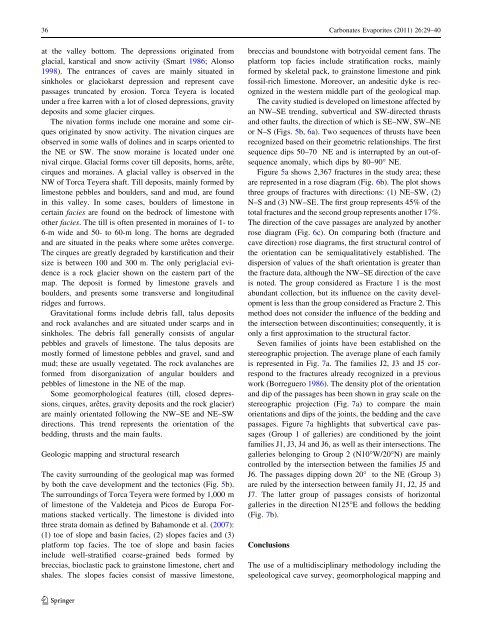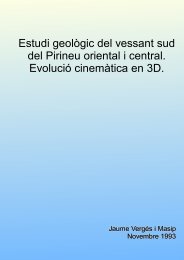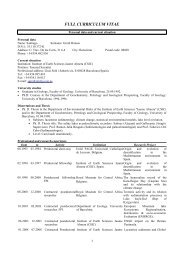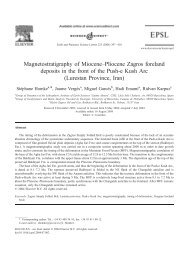1.3 MB - Instituto de Ciencias de la Tierra Jaume Almera
1.3 MB - Instituto de Ciencias de la Tierra Jaume Almera
1.3 MB - Instituto de Ciencias de la Tierra Jaume Almera
Create successful ePaper yourself
Turn your PDF publications into a flip-book with our unique Google optimized e-Paper software.
36 Carbonates Evaporites (2011) 26:29–40<br />
at the valley bottom. The <strong>de</strong>pressions originated from<br />
g<strong>la</strong>cial, karstical and snow activity (Smart 1986; Alonso<br />
1998). The entrances of caves are mainly situated in<br />
sinkholes or g<strong>la</strong>ciokarst <strong>de</strong>pression and represent cave<br />
passages truncated by erosion. Torca Teyera is located<br />
un<strong>de</strong>r a free karren with a lot of closed <strong>de</strong>pressions, gravity<br />
<strong>de</strong>posits and some g<strong>la</strong>cier cirques.<br />
The nivation forms inclu<strong>de</strong> one moraine and some cirques<br />
originated by snow activity. The nivation cirques are<br />
observed in some walls of dolines and in scarps oriented to<br />
the NE or SW. The snow moraine is located un<strong>de</strong>r one<br />
nival cirque. G<strong>la</strong>cial forms cover till <strong>de</strong>posits, horns, arête,<br />
cirques and moraines. A g<strong>la</strong>cial valley is observed in the<br />
NW of Torca Teyera shaft. Till <strong>de</strong>posits, mainly formed by<br />
limestone pebbles and boul<strong>de</strong>rs, sand and mud, are found<br />
in this valley. In some cases, boul<strong>de</strong>rs of limestone in<br />
certain facies are found on the bedrock of limestone with<br />
other facies. The till is often presented in moraines of 1- to<br />
6-m wi<strong>de</strong> and 50- to 60-m long. The horns are <strong>de</strong>gra<strong>de</strong>d<br />
and are situated in the peaks where some arêtes converge.<br />
The cirques are greatly <strong>de</strong>gra<strong>de</strong>d by karstification and their<br />
size is between 100 and 300 m. The only perig<strong>la</strong>cial evi<strong>de</strong>nce<br />
is a rock g<strong>la</strong>cier shown on the eastern part of the<br />
map. The <strong>de</strong>posit is formed by limestone gravels and<br />
boul<strong>de</strong>rs, and presents some transverse and longitudinal<br />
ridges and furrows.<br />
Gravitational forms inclu<strong>de</strong> <strong>de</strong>bris fall, talus <strong>de</strong>posits<br />
and rock ava<strong>la</strong>nches and are situated un<strong>de</strong>r scarps and in<br />
sinkholes. The <strong>de</strong>bris fall generally consists of angu<strong>la</strong>r<br />
pebbles and gravels of limestone. The talus <strong>de</strong>posits are<br />
mostly formed of limestone pebbles and gravel, sand and<br />
mud; these are usually vegetated. The rock ava<strong>la</strong>nches are<br />
formed from disorganization of angu<strong>la</strong>r boul<strong>de</strong>rs and<br />
pebbles of limestone in the NE of the map.<br />
Some geomorphological features (till, closed <strong>de</strong>pressions,<br />
cirques, arêtes, gravity <strong>de</strong>posits and the rock g<strong>la</strong>cier)<br />
are mainly orientated following the NW–SE and NE–SW<br />
directions. This trend represents the orientation of the<br />
bedding, thrusts and the main faults.<br />
Geologic mapping and structural research<br />
The cavity surrounding of the geological map was formed<br />
by both the cave <strong>de</strong>velopment and the tectonics (Fig. 5b).<br />
The surroundings of Torca Teyera were formed by 1,000 m<br />
of limestone of the Val<strong>de</strong>teja and Picos <strong>de</strong> Europa Formations<br />
stacked vertically. The limestone is divi<strong>de</strong>d into<br />
three strata domain as <strong>de</strong>fined by Bahamon<strong>de</strong> et al. (2007):<br />
(1) toe of slope and basin facies, (2) slopes facies and (3)<br />
p<strong>la</strong>tform top facies. The toe of slope and basin facies<br />
inclu<strong>de</strong> well-stratified coarse-grained beds formed by<br />
breccias, bioc<strong>la</strong>stic pack to grainstone limestone, chert and<br />
shales. The slopes facies consist of massive limestone,<br />
123<br />
breccias and boundstone with botryoidal cement fans. The<br />
p<strong>la</strong>tform top facies inclu<strong>de</strong> stratification rocks, mainly<br />
formed by skeletal pack, to grainstone limestone and pink<br />
fossil-rich limestone. Moreover, an an<strong>de</strong>sitic dyke is recognized<br />
in the western middle part of the geological map.<br />
The cavity studied is <strong>de</strong>veloped on limestone affected by<br />
an NW–SE trending, subvertical and SW-directed thrusts<br />
and other faults, the direction of which is SE–NW, SW–NE<br />
or N–S (Figs. 5b, 6a). Two sequences of thrusts have been<br />
recognized based on their geometric re<strong>la</strong>tionships. The first<br />
sequence dips 50–70 NE and is interrupted by an out-ofsequence<br />
anomaly, which dips by 80–90° NE.<br />
Figure 5a shows 2,367 fractures in the study area; these<br />
are represented in a rose diagram (Fig. 6b). The plot shows<br />
three groups of fractures with directions: (1) NE–SW, (2)<br />
N–S and (3) NW–SE. The first group represents 45% of the<br />
total fractures and the second group represents another 17%.<br />
The direction of the cave passages are analyzed by another<br />
rose diagram (Fig. 6c). On comparing both (fracture and<br />
cave direction) rose diagrams, the first structural control of<br />
the orientation can be semiqualitatively established. The<br />
dispersion of values of the shaft orientation is greater than<br />
the fracture data, although the NW–SE direction of the cave<br />
is noted. The group consi<strong>de</strong>red as Fracture 1 is the most<br />
abundant collection, but its influence on the cavity <strong>de</strong>velopment<br />
is less than the group consi<strong>de</strong>red as Fracture 2. This<br />
method does not consi<strong>de</strong>r the influence of the bedding and<br />
the intersection between discontinuities; consequently, it is<br />
only a first approximation to the structural factor.<br />
Seven families of joints have been established on the<br />
stereographic projection. The average p<strong>la</strong>ne of each family<br />
is represented in Fig. 7a. The families J2, J3 and J5 correspond<br />
to the fractures already recognized in a previous<br />
work (Borreguero 1986). The <strong>de</strong>nsity plot of the orientation<br />
and dip of the passages has been shown in gray scale on the<br />
stereographic projection (Fig. 7a) to compare the main<br />
orientations and dips of the joints, the bedding and the cave<br />
passages. Figure 7a highlights that subvertical cave passages<br />
(Group 1 of galleries) are conditioned by the joint<br />
families J1, J3, J4 and J6, as well as their intersections. The<br />
galleries belonging to Group 2 (N10°W/20°N) are mainly<br />
controlled by the intersection between the families J5 and<br />
J6. The passages dipping down 20° to the NE (Group 3)<br />
are ruled by the intersection between family J1, J2, J5 and<br />
J7. The <strong>la</strong>tter group of passages consists of horizontal<br />
galleries in the direction N125°E and follows the bedding<br />
(Fig. 7b).<br />
Conclusions<br />
The use of a multidisciplinary methodology including the<br />
speleological cave survey, geomorphological mapping and





